In
the Sea of Japan
Hegura Island
(Hegurajima)
some notes by Armas
Hill,
and a list of birds
during 7 FONT tours on the island
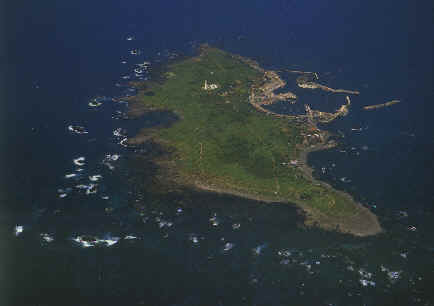
It's an intriguing place, Hegurajima,
where during the spring and fall migrations, there's some of the most
fascinating birding anywhere. Hegura is a small island, actually tiny. It's less than
1 kilometer wide and less than 2 kilometers long. One can walk the path around the
entire coastline of the island in less than an hour.
Some people live on the island. But not many, about 50. There was a small store
(no longer), but there is an
inn (where fortunately, where one can overnight and have meals). Also on the
island: some homes, a school (just recently closed; there was an enrollment of 5), and 1
doctor. The most prominent
structure on the island is a lighthouse (the white tower in the photo above).
In the morning, the women of
Hegura dive for seaweed. Later in the day, if sunny, they put it out to dry. Men go out on
boats to fish.
There's a ferry once a day, in each direction, to and from the island. It's less
than a
two-hour ferry ride from mainland Honshu, during which there can be some good
seabirding. In the spring, the endemic Japanese Murrelet, the "Kanmuri-umisuzume"
(a wonderful bird with a wonderful name) can be seen from the
boat, along with Rhinoceros Auklets that breed nearby. Streaked
Shearwaters and Red-necked Phalaropes can be numerous.
But it's on the island itself where birding can really get interesting. At
night, when many landbirds in the spring are migrating north, they come upon the
small island in the sea. Given optimum conditions, in the morning, the island
can be bursting with birds. They're in the open on fields, in bushes, small
trees, under debris by the homes, and along the rocky coast. In short, they're
everywhere.
Birds that elsewhere can be notorious skulkers, are often more
out in the open. In that category, for example, are the shy Japanese Robin,
Siberian Blue Robin, and the White's Ground Thrush.
Routine migrants are enroute from where they've wintered in the Asian tropics to
where they'll breed as far north as Siberia. These include the Siberian
Rubythroat, Siberian Stonechat, and Yellow-breasted Bunting.
Birds migrating north, generally more common on the Asian mainland in China and
Korea, are readily seen. There are a number of birds in that
category that we've seen during our 7 previous FONT tours on Hegura Island.
These birds have included: Chinese Egret, Chinese Pond Heron, Purple Heron, Hoopoe, Richard's Pipit,
Tree Pipit, Pied Wheatear, Isabelline Wheatear, White-throated Rock Thrush, Swinhoe's (or Rufous-tailed) Robin,
Dusky Warbler, Radde's Warbler, Mugimaki Flycatcher, Tricolored Flycatcher,
Taiga (formerly part of Red-breasted) Flycatcher, Purple-backed
(or Daurian)
Starling, Black-naped Oriole, Black Drongo, Chinese Grosbeak, Chestnut Bunting,
Little Bunting, Yellow-browed Bunting, and Tristram's
Bunting.
A list of all the bird species (totaling 179) that have been seen during our 7 FONT Hegura Island
tours during the spring (in late-April & in early and mid-May) follows,
including those seen nearby from the ferry.
In 2007, we
added 22 species to the list.
In 2010, we added yet another 8 species, including our
first Eurasian Tree Sparrow (1 bird). The Eurasian Tree Sparrow
is extremely common, and widespread, throughout Japan (other than on Hegura).
If you'd really like to go a place in this world, that's totally removed from
everything, from hustle, bustle, troubles, whatever, Hegura is it. And it's a
place that's fun to bird - a bit like a fantasy, where a birder can be completely immersed in birds.
There's another fascinating aspect of this "bird island" during
migration. It's the mingling that can be done with Japanese birders. They're
very helpful in sharing what's about. And the whole experience we would have with them is
one never to be forgotten.
During a good day in early or mid-May, with a fallout of landbirds, shorebirds,
and waterbirds, nearly a hundred species could be seen on the tiny island
of Hegura. That's more birds during a day than virtually anywhere else in Japan.
And every day can be different, each with a surprise or two, something totally
unexpected.
A COMPLETE LISTING OF THE BIRDS FOUND DURING OUR 7 TOURS ON HEGURA ISLAND
FOLLOWS.
Links:
Upcoming
FONT Birding & Nature Tours in Japan
A List & Photo Gallery of Japan Birds,
in 2 parts
Birds
found during FONT Japanese Birding Tours in the Spring

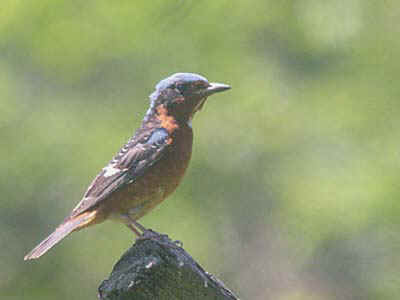

A White-throated Rock
Thrush, Monticola gularis,
during the FONT tour on Hegura Island, Japan, May 21, 2005.
This species is an
ultra-rarity in Japan.
It is normally on mainland Asia,
breeding mostly in Manchuria and eastern Siberia,
and wintering in southern
China, and further south in Southeast Asia.
Note in the top photo the white patch on the throat.
(top photograph by Iwasaki Shohgo,
other 2 photographs by
Katsuyuki
Genma)
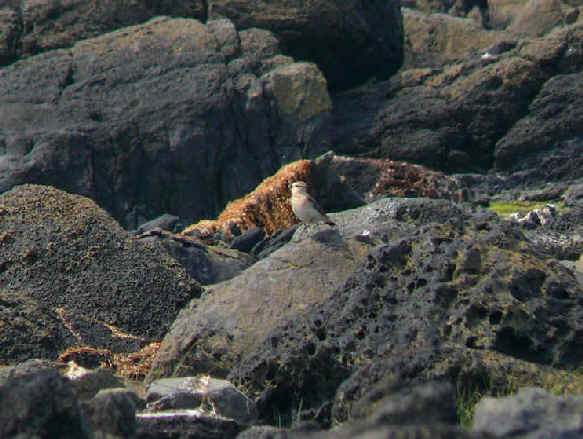
This Isabelline Wheatear was seen
along the rocky coastline of Hegura Island
during the FONT tour in May 2007.
The species normally occurs in central and western Asia,
and winters in Africa.
(We've seen the bird during FONT tours in Turkey.)
Somehow, this bird made its way to Hegura Island in the Sea of Japan.
When "A Field Guide to the Birds of Japan" was published in 1982,
there was only one record of this species for Japan.
More bird photographs are
included the following bird list.
BIRDS
SEEN DURING FONT SPRING TOURS
ON HEGURA ISLAND
(and in nearby waters)
(in mid-April & in early and mid-May)
mid-apr: April 11-20
early- may: May 1-10
mid-may: May 11-21
The dates of the FONT tours on Hegura have been:
01 - April 16-17, 2001
02 - May 6-7, 2002
04 - May 15-18, 2004
05 - May 19-21, 2005
06 - May 10-12, 2006
07 - May 9-12, 2007
10 - May 16-18, 2010
Bird names given in both English
& Japanese.
- Pacific Loon (or Diver) ______
mid-apr, early-may, mid-may 01, 06, 10
Gavia pacifica
Shiroeri-ohamu
- Little Grebe ______ early-may,
mid-may 07
Tachybaptus ruficollis
Kaitsuburi
- Great Crested Grebe ______
mid-apr 01
Podiceps cristatus
Kanmuri-kaitsuburi
- Streaked Shearwater ______
mid-apr, early-may, mid-may 01, 02, 04, 05, 06, 07,
10
Calonectris leucomelas
O-mizunagidori
- Short-tailed Shearwater ______
mid-apr 01
Puffinus tenuirostris
Hashiboso-mizunagidori
- Temminck's (or Japanese) Cormorant ______
mid-apr, early-may, mid-may 01, 02, 04, 05, 06, 07,
10
Phalacrocorax capillatus
Umi-u
- Pelagic Shag (or Cormorant) ______ mid-apr, early-may, mid-may
01, 04, 05, 06, 07, 10
Phalacrocorax pelagicus
Hime-u
- Black-crowned Night-Heron ______
mid-apr, early may, mid-may 01, 04, 05, 07, 10
Nycticorax nycticorax
Goi-sagi
- Striated Heron ______
early-may 07
Butorides striata amurensis
Sasa-goi
- Eastern Cattle Egret ______ early-may, mid-may
02, 04, 05, 06, 07
Bubulcus coromandus
Ama-sagi
- Little Egret ______ mid-apr, early-may,
mid-may 01, 02, 04, 06, 07, 10
Egretta garzetta
Ko-sagi
- Chinese (or Swinhoe's) Egret
(rare in Japan) ______ early-may, mid-may 06
Egretta eulophotes
Kara-shira-sagi
- Intermediate Egret ______
early-may, mid-may 04, 05, 06, 07, 10
Mesophoyx (formerly Egretta) intermedia
Chu-sagi
- Great Egret ______ mid-apr, early-may, mid-may
01, 02, 04, 05, 06, 07, 10
Casmerodius albus (has been placed in the genus Ardea)
Dai-sagi
- Grey Heron ______ mid-apr, early-may, mid-may
01, 02, 04, 05, 06, 07, 10
Ardea cinerea
Ao-sagi
- Purple Heron (rare
in Japan) ______
early-may, mid-may 06, 07
Ardea purpurea
Murasaki-sagi
- Pacific (or Eastern) Reef-Heron ______ mid-may
04
Egretta sacra
Kuro-sagi
- Chinese Pond Heron
(rare in Japan) ______
early-may, mid-may 06, 07
Ardeola bacchus
Akagashira-sagi
- Eurasian Wigeon ______
early-may, mid-may 02, 04, 06
Anas penelope
Hidori-gamo
- Mallard ______ early may, mid-may
04, 05, 07
Anas platyrhynchos
Ma-gamo
- Eastern Spot-billed Duck ______ mid-apr, early-may, mid-may
01, 02, 04, 05, 06, 07, 10
Anas zonorhyncha
Karu-gamo
- Red-breasted Merganser ______ mid-may
04
Mergus serrator
Umi-aisa
- Black-eared Kite ______
mid-apr, early-may, mid-may 01, 02, 04, 05, 06, 07,
10
Milvus lineatus
Tobi
- Osprey ______ mid-may 04,
10
Pandion haliaetus
Misago
- Oriental
Honey Buzzard ______ mid-may 05, 10
Pernis orientalis
Hachikuma
- Eastern Marsh Harrier
(was considered conspecific with Western Marsh Harrier of Europe, and
was then
called Northern Marsh Harrier) ______ mid-may 04
Circus spilonotus
Chuhi
- Hen Harrier (has been considered conspecific with
American Northern Harrier) ______ mid-may 04
Circus cyaneus
Haiiro-chuhi
- Eurasian Sparrowhawk ______
mid-may 07
Accipiter nisus
Hai-taka
- Japanese (or Lesser) Sparrowhawk ______
early may, mid-may 04, 06, 07, 10
Accipiter gularis
Tsumi
- Eastern Buzzard ______
mid-may 10
Buteo japonicus
Nosuri
- Grey-faced Buzzard ______
mid-may 06
Butastur indicus
Sashiba
- Eurasian Kestrel ______
mid-may 10
Falco tinnunculus
Chogenbo
- Eurasian Hobby ______ early
may, mid-may 04, 06, 07
Falco subbuteo
Chigo-hayabusa
- Amur Falcon (has been
called Eastern Red-footed Falcon) ______ 10
Falco amurensis
Akaashi-chogenbo
- Peregrine Falcon ______ mid-may
04, 05, 06, 07, 10
Falco peregrinus
Hayabusa
- Ruddy (-breasted) Crake
______ mid-may 04
Porzana fusca
Hi-kuina
- Common Moorhen ______
early may, mid-may 04, 07
Galinula chloropus
Ban
- Eurasian Coot ______
early-may, mid-may 06
Fulica atra
O-ban
- Common Ringed Plover ______ early-may
07
Charadrius hiaticula
Hajiro-ko-chidori
- Little Ringed Plover ______
mid-apr 01
Charadrius dubius
Ko-chidori
- Lesser Sandplover (or
Mongolian Plover) ______ mid-may 04, 06
Charadrius mongolus
Medai-chidori
- Pacific Golden Plover ______
early may, mid-may 04
Pluvialis fulva
Munaguro
- Red Knot ______ mid-may
04
Ko-oba-shigi
- Sanderling ______ mid-may
04
Miyubi-shigi
- Red-necked Stint ______ mid-may
04, 06
Tonen
- Long-toed Stint ______
mid-may 07
Hibari-shigi
- Ruddy Turnstone ______ mid-may
04, 06
Kyojo-shigi
- Common Snipe ______ mid-apr,
early may, mid-may 01, 04, 06, 07
Gallinago gallinago
Ta-shigi
- Latham's Snipe ______ early
may, mid-may 04, 06, 07
Gallinago hardwickii
Oji-shigi
- Jacksnipe ______ mid-apr
01
Lymnocryptes minimus
Ko-shigi
- Wood Sandpiper ______ early-may,
mid-may 07
Tringa glareola
Takabu-shigi
- Common Greenshank ______
early may, mid-may 04, 07
Tringa nebularia
Aoashi-shigi
- Green Sandpiper ______ mid-apr,
early may, mid-may 01, 06, 07
Tringa ochropus
Kusa-shigi
- Common Sandpiper ______ mid-apr,
early may, mid-may 01, 04, 05, 06, 07, 10
Actitis hypoleucos
Iso-shigi
- Grey-tailed (or Polynesian) Tattler ______
early may, mid-may 04, 05, 06, 07, 10
Tringa brevipes
Kiashi-shigi
- Terek Sandpiper ______ mid-may
07
Xenus cinereus
Sorihashi-shigi
- Eastern Black-tailed Godwit ______
mid-may 06
Limosa melanuroides
Oguro-shigi
- "Eurasian" Whimbrel
______ mid-may 07
Numenius phaeopus variegatus
Chushaku-shigi
- Red-necked Phalarope ______
early-may, mid-may 02, 04, 06, 07, 10
Phalaropus lobatus
Akaeri-hireashi-shigi
- Black-headed Gull ______ early-may
02
Chroicocephalus ridibundus
Yuri-kamone
- Black-tailed Gull ______ mid-apr, early-may, mid-may
01, 02, 04, 05, 06, 07, 10
Larus crassirostris
Umineko
- Vega (Herring) Gull ______
mid-apr, early-may, mid-may 01, 02, 04, 05, 06, 07,
10
Larus vegae
Seguro-kamone
- Slaty-backed Gull ______ mid-may
04, 06, 07, 10
Larus schistisagus
O-seguro-kamone
- Glaucous-winged Gull ______
early may, mid-may 06, 07
Larus glaucescens
Washi-kamome
- Common Tern ______ early-may
06
Sterna hirundo longipennis
Ajisashi
- Japanese Murrelet ______ mid-apr,
early-may, mid-may 01, 04, 06, 07
Synthliboramphus wumizusume
Kanmuri-umisuzume
- Ancient Murrelet ______
mid-may 10
Synthliboramphus a, antiquus
Umisuzume
- Rhinoceros Auklet ______ mid-apr,
early-may 01, 06, 10
Cerorhinca monocerata
Utou
- Common (or Feral) Pigeon ______ mid-apr, early-may, mid-may
01, 02, 04, 05, 06, 07
Columba livia
Dobato
- Oriental (or Rufous) Turtle Dove ______
mid-apr, early-may, mid-may 01, 02, 04, 05, 06, 07,
10
Streptopelia orientalis
Kiji-bato
- Black Wood Pigeon ______ mid-may
04, 10
Columba janthina
Karasu-bato
- Eurasian Cuckoo ______ early-may, mid-may
05, 06, 10
Cuculus canorus
Kakko
- Oriental Cuckoo ______
early may, mid-may 04, 06, 07, 10
Cuculus optatus
Tsutsudori
- Lesser Cuckoo ______ mid-may
04, 05, 06, 10
Cuculus poliocephalus
Hototo-gisu
- Japanese Scops-Owl (has
been considered part of
Collared Scops-Owl) ______ early-may, mid-may 04, 05, 06,
10
Otus semitorques
O-konoha-zuku
- Brown Hawk-Owl ______ mid-may
05
Ninox scutulata
Aoba-zuku
- Grey Nightjar
______ early-may 06
Caprimulgus jotaka
Yotaka
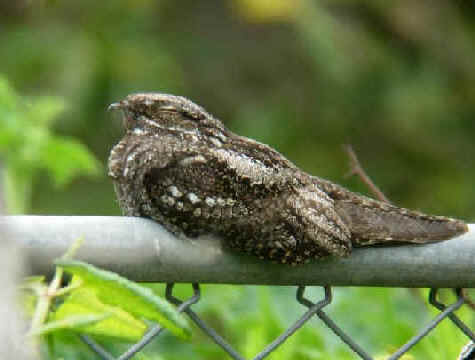
GreyNightjar photographed on Hegura island during the FONT tour in 2006
- Pacific Swift (another
name is Asian White-rumped Swift) ______ early may, mid-may 04, 05, 07,
10
Apus pacificus
Amatsu-bame
- Common (or Eurasian) Kingfisher ______ early-may, mid-may
02, 04, 07, 10
Kawasemi
- Ruddy Kingfisher ______
early-may, mid-may 07
Halcyon coromanda
Aka-shobin
- Black-capped Kingfisher
(rare in Japan) ______ mid-may 05
Halcyon pileata
Yama-shobin
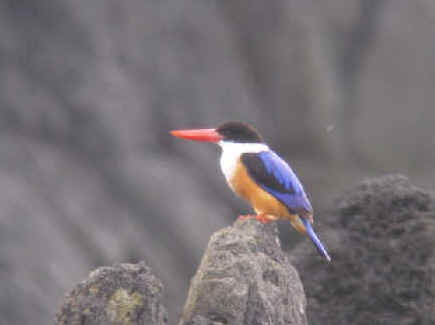
Black-capped
Kingfisher
- Eurasian Hoopoe (rare
in Japan) ______ mid-apr,
mid-may 01, 05, 10
Upupa epops
Yatsugashira
- Oriental Dollarbird (closely
related to Broad-billed Roller of Africa) ______ mid-may 05, 06,
10
Eurystomus orientalis
Bupposo
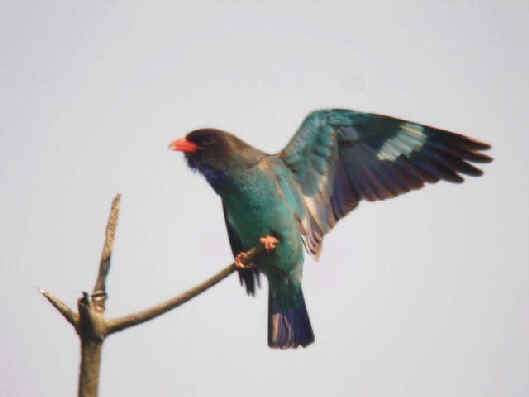
Oriental
Dollarbird
- Greater Short-toed Lark
(rare in Japan) ______
mid-apr, mid-may 01,
10
Calandrella brachydactyla
Hime-kotenshi
- Eurasian
Skylark (on Hegura, not the "Japanese Skylark", but
rather Alauda arvensis pekinensis of the Asian mainland)
______ mid-apr,
mid-may 01, 10
Alauda arvensis
Hibari
- Barn Swallow ______ mid-apr, early-may, mid-may
01, 02, 04, 05, 06, 07, 10
Hirundo rustica gutturalis
Tsubame
- Sand Martin (or Bank
Swallow) ______
mid-apr, mid-may 01
Riparia riparia
Shodo-tsubame
- Red-rumped Swallow ______ early-may, mid-may
04
Cecropis (formerly Hirundo) daurica
Koshiaka-tsubame
- Richard's Pipit
(very rare in Japan) ______
mid-may 05, 07
Anthus richardi
Mamijiro-tahibari
- Olive-backed Pipit (was called
Indian Tree Pipit) ______ mid-apr,
early-may, mid-may 01, 02, 04, 05, 07, 10
Anthus hodgsoni
Binzui
- Tree Pipit (very
rare in Japan) ______ early-may
07
Anthus trivialis
Yoroppa-binzui
- "Siberian"
Buff-bellied Pipit (subspecies japonicus; has been considered the same
species as the American Pipit, subspecies rubescens, but they may be
specifically distinct) (was, at one time, part of the Water Pipit of the Holarctic, that species now
in Eurasia, Anthus
spinoletta) ______ mid-apr, mid-may 01, 06, 07
Anthus rubescens japonicus
Tahibari
- Eastern Yellow Wagtail (rare
in Japan) ______ early may, mid-may 04, 05, 06, 07
Motacilla tschutschensis (a couple different subspecies, in
migration, are possible on Hegura Island)
Tsumenaga-sekirei
- Grey Wagtail ______ mid-apr, early-may, mid-may
01, 02, 04, 05, 07
Motacilla cinerea
Ki-sekirei
- White (or Pied) Wagtail (mostly
the subspecies Motacilla alba lugens, that has been known as the Black-backed
Wagtail; also
the subspecies M. a. ocularis) ______ mid-apr, early-may, mid-may
01, 02, 04, 05, 06, 07, 10
Motacilla alba
Hojiro (or Haku-sekirei)
- Brown-eared Bulbul ______ early-may, mid-may
02, 04, 07, 10
Microscelis (formerly Hypsipetes) a. amaurotis
Hiyodori
- Ashy Minivet ______ mid-may
04, 06, 07
Pericrocotus divaricatus
Sanshokui
- Japanese Waxwing ______
mid-may 10
Bombycilla japonica
Hi-renjaku
- Pied Wheatear ______
mid-may 07
Oenanthe pleschanka
Seguro-sabaku-hitaki
- Isabelline Wheatear ______
early-may, mid-may 07
Oenanthe isabellina
Inaba-hitaki
- Japanese Robin ______ mid-apr
01
Luscinia akahige
Komadori
- Swinhoe's (or Rufous-tailed) Robin
(rare in Japan) ______ early-may, mid-may 02, 04, 06, 07
Luscinia sibilans
Shima-goma
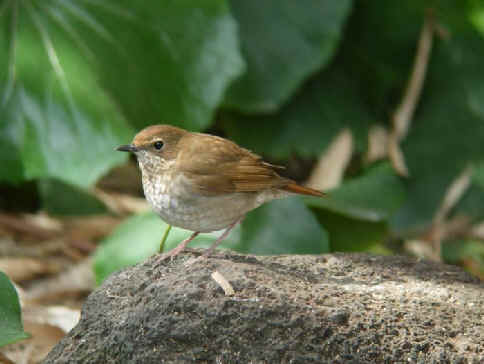
Swinhoe's
Robin
- Siberian Blue Robin ______ early-may, mid-may
02, 04, 05, 06, 07,10
Luscinia cyane
Ko-ruri
- Siberian Rubythroat ______
mid-apr, early-may, mid-may 01, 04, 05, 06, 07.
10
Luscinia calliope camtschatkensis
No-goma
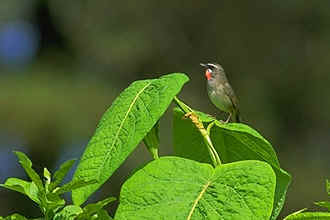
Siberian
Rubythroat
- Bluethroat ______
07
Luscinia s. svecica (this subspecies the:
"Red-spotted" or "Arctic" Bluethroat)
Ogawa-komadori
- Daurian Redstart ______ mid-apr, mid-may
01, 04
Phoenicurus auroreus
Jo-bitaki
- Red-flanked Bluetail (also known as Siberian Bluechat
or Orange-flanked Bush-Robin) ______ mid-apr, early-may,
mid-may 01, 02, 06, 07, 10
Luscinia cyanura
Ruri-bitaki

Red-flanked
Bluetail
- Siberian Stonechat ______
mid-apr, early-may, mid-may 01, 02, 04, 06, 07,
10
Saxicola maurus stejnegeri
No-bitaki
- Black Redstart (rare
in Japan) ______ mid-apr
(rare in Japan) 01
Phoenicurus ochruros
Kuro-jo-bitaki
- Blue Rock Thrush (red-bellied form) ______
mid-apr, early-may, mid-may 01, 02, 04, 05, 06, 07,
10
Monticola solitarius philippensis
Iso-hiyodori
- White-throated Rock Thrush
(very rare in Japan) ______ mid-may 05
Monticola gularis
Hime-isohiyo
- White's (Ground) Thrush ______ late-apr, early-may, mid-may
01, 02, 04, 06, 07
Zoothera dauma
Tora-tsugumi
- Siberian (Ground) Thrush ______
early-may, mid-may 04, 05, 06, 07, 10
Zoothera sibirica
Mamijiro
- Brown-headed Thrush ______
mid-apr, early-may, mid-may 01, 02, 04, 07, 10
Turdus chrysolaus
Akahara
- Pale Thrush ______ mid-apr, early-may, mid-may
01, 02, 04, 07, 10
Turdus pallidus
Shirohara
- Eye-browed (or Grey-headed) Thrush ______ early-may, mid-may
02, 04, 05, 06, 07, 10
Turdus obscurus
Mamichajinai
- Dusky Thrush ______ mid-apr, early-may, mid-may
01, 02, 04, 05, 06, 07, 10
Turdus eunomus
Tsugumi
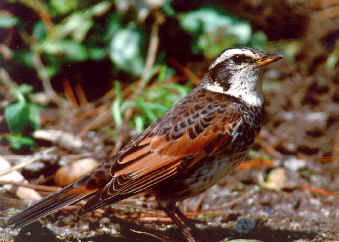
Dusky Thrush
- Naumann's Thrush (was part of Dusky
Thrush) ______ mid-apr, early-may, mid-may 01, 07,
10
Turdus naumanni
Tsugumi
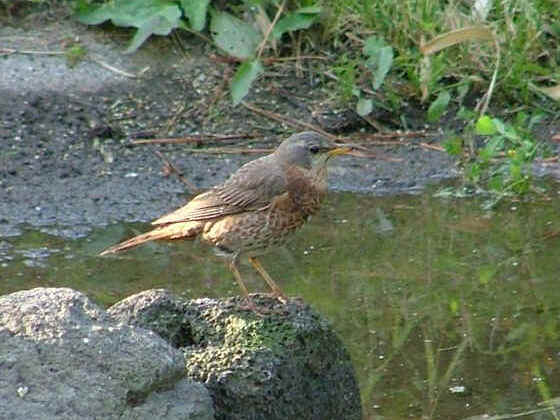
Naumann's
Thrush
- Japanese (Grey) Thrush ______
mid-apr, early-may, mid-may 01, 02, 04, 06, 10
Turdus cardis
Kuro-tsugumi
- Asian Stubtail (was called
Short-tailed Bush-Warbler) ______ mid-apr 01
Urosphena squameiceps
Yabusame
- Japanese Bush Warbler ______
mid-apr, early-may, mid-may 01, 02, 04, 05, 06, 07,
10
Cettia diphone
Uguisu
- Zitting Cisticola
______ mid-may 10
Cisticola juncidis
Sekka
- Oriental Reed Warbler ______
mid-apr, early-may, mid-may 01, 02, 04, 05, 06,
10
Acrocephalus orientalis
O-yoshikiri
- Black-browed (or Schenk's) Reed Warbler ______
early-may, mid-may 04, 05, 06, 07, 10
Acrocephalus bistrigiceps
Ko-yoshikiri
- Gray's Warbler (was
called Gray's Grasshopper Warbler) ______ mid-may 05, 07
Locustella fasciolata
Ezo-sennyu
- Eastern Crowned Warbler ______
mid-apr, early-may, mid-may 01, 02, 04, 05, 06, 07,
10
Phylloscopus coronatus
Sendai-mushikui
- Sakhalin Leaf Warbler
(was part of the Pale-legged Leaf Warbler) ______
mid-apr,
early-may, mid-may 01, 02, 04, 05, 06, 07, 10
Phylloscopus borealoides
Ezo-mushikui
- Siberian Chiffchaff
(very rare in Japan) ______ mid-may 10
Phylloscopus tristis
(Japanese name unknown)
- Yellow-browed Warbler ______
early-may, mid-may 04, 07, 10
Phylloscopus inornatus
Kimayu-mushikui
- Dusky Warbler (rare
in Japan) ______ early-may, mid-may 02, 07
Phylloscopus fuscatus
Muji-sekka
- Radde's Warbler
(rare in Japan)
______ mid-may 07
Phylloscopus schwarzi
Karafuto-muji-sekka
- Arctic Warbler (subspecies borealis) ______
early-may, mid-may 04, 05, 06, 07, 10
Phylloscopus borealis
Meboso-mushikui
- Blue-and-white Flycatcher ______
mid-apr, early-may, mid-may 01, 02, 04, 05, 06, 07
Cyanoptila cyanomelana
O-ruri
- Asian Brown Flycatcher ______
mid-apr, early-may, mid-may 01, 02, 04, 05, 06, 07,
10
Muscicapa dauurica
Ko-same-bitaki
- Dark-sided (or Siberian) Flycatcher ______
early-may, mid-may 04, 05, 06, 07, 10
Muscicapa sibirica
Same-bitaki
- Grey-streaked Flycatcher ______ mid-may
04, 05, 06, 07
Muscicapa griseisticta
Ezo-bitaki
- Mugimaki Flycatcher ______ early-may, mid-may
(rare in Japan) 02, 04, 05, 06, 07, 10
Ficedula mugimaki
Mugimaki
- Narcissus Flycatcher ______
mid-apr, early-may, mid-may 01, 02, 04, 05, 06, 07,
10
Ficedula narcissina
Ki-bitaki
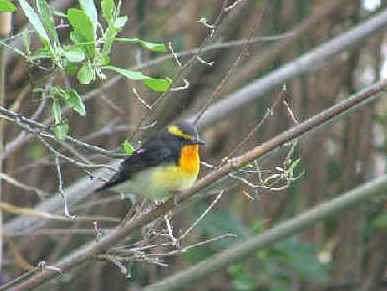
Narcissus Flycatcher
- Yellow-rumped (or Tricolored) Flycatcher
(rare in Japan) ______
early-may, mid-may 04, 06, 07
Ficedula zanthopygia
Mamijiro-ki-bitaki
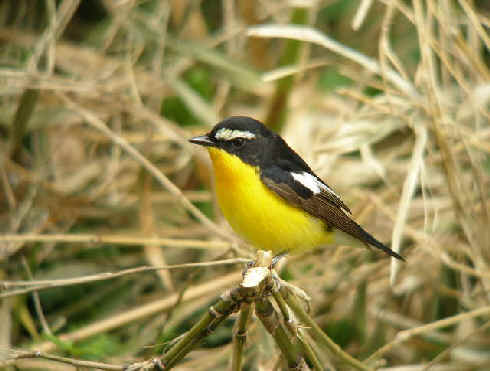
Yellow-rumped
(or Tricolored) Flycatcher
-
Taiga Flycatcher (was part of Red-breasted Flycatcher)
(rare in Japan) _____ mid-may (rare in Japan)
05
Ficedula albicilla
Ojiro-bitaki
- Japanese Paradise Flycatcher
______ mid-may 05, 06
Terpsiphone atrocaudata
Sankocho
- Coal Tit ______ mid-apr
01
Periparus (formerly Parus) ater
Hi-gara
- Varied Tit ______
early-may 07
Poecile (formerly Parus) varius
Yama-gara
- Japanese White-eye ______
mid-apr, early-may, mid-may 01, 02, 04, 05, 07,
10
Zosterops japonicus
Mejiro
- Bull-headed Shrike ______
mid-apr, mid-may 01, 04, 05, 07, 10
Lanius bucephalus
Mozu
- Brown Shrike ______
early-may, mid-may 04, 05, 06, 07
Lanius cristatus
Aka-mozu
- Tiger (or Thick-billed) Shrike ______ mid-may
04, 05
Lanius tigrinus
Chigo-mozu
- Rook ______ mid-apr,
early-may 01, 06
Corvus frugilegus
Miyama-garasu
- Carrion Crow ______ mid-apr,
early-may, mid-may 01, 04, 06, 07, 10
Corvus corone orientalis
Hashiboso-garasu
- Large-billed Crow ______ mid-apr, early-may, mid-may
01, 02, 04, 05, 06, 07, 10
Corvus macrorhynchos
Hashibuto-garasu
- Chestnut-cheeked Starling ______ early-may, mid-may
02, 04, 05, 06, 07, 10
Sturnus philippensis
Ko-mukudori
- White-cheeked (or Grey) Starling ______
mid-apr, mid-may (seen only infrequently on Hegura) 01, 02, 05, 07
Sturnus cineraceus
Mukudori
- Daurian
Starling (also called Purple-backed Starling) (rare in Japan) ______ mid-may 07
Sturnus sturninus
Shiberia-mukudori
- Black-naped Oriole (rare
in Japan) ______
early-may, mid-may 04, 05, 07
Oriolus chinensis
Korai-uguisu
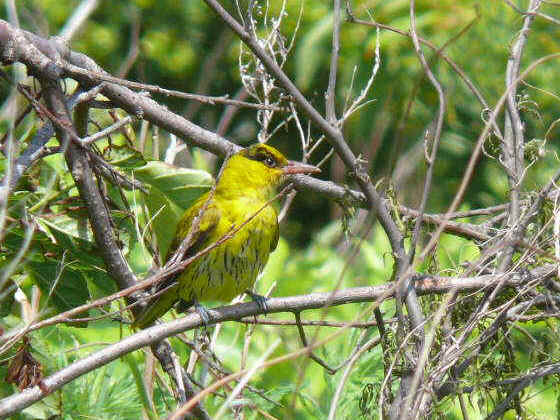
Black-naped
Oriole
- Black Drongo (rare
in Japan) ______ mid-may 07
Dicrurus macrocercus
Ochu
- Eurasian Tree Sparrow
______ mid-may 10 (1 bird)
Passer montanus
Suzume
- Russet (or Cinnamon) Sparrow ______
mid-apr 01
Passer rutilans
Nyunai-suzume
- Brambling ______ mid-apr, early-may,
mid-may 01, 02, 06, 07, 10
Fringilla montifringilla
Atori
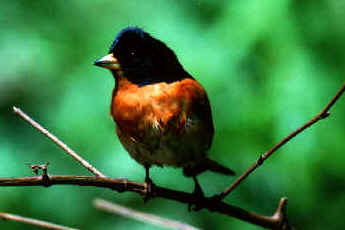
Brambling
- Oriental Greenfinch (has
also been called Grey-capped Greenfinch) ______
mid-apr, early-may, mid-may 01, 02, 04, 05, 06, 07,
10
Fringilla coelebs
Kawara-hiwa
- Eurasian Siskin ______ mid-apr, early-may, mid-may
01, 02, 04, 05, 06, 07
Carduelis flammea
Ma-hiwa
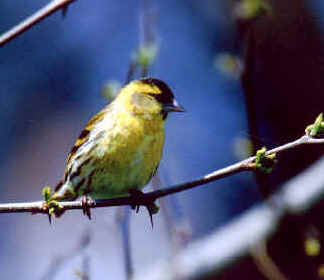
Eurasian Siskin
- Asian Rosy Finch ______ mid-apr
01
Leucosticte arctoa
Hagi-mashiko
- Long-tailed Rosefinch ______
mid-apr 01
Uragus sibiricus
Beni-mashiko
- Eurasian Bullfinch ______
mid-apr, early-may, mid-may 01, 04
Pyrrhula pyrrhula
Uso
- Japanese Grosbeak ______
early-may, mid-may 04, 05, 07, 10
Eophona personata
Ikaru
- Chinese Grosbeak
(has also been called Yellow-billed Grosbeak, but both the Chinese
& Japanese Grosbeaks have yellow bills) (rare in Japan) ______
mid-may 07
Eophona migratoria
Ko-ikaru

Chinese Grosbeaks
- Hawfinch ______ mid-apr,
early-may, mid-may 01, 04, 05, 06, 07, 10
Coccothraustes coccothraustes
Shime
- (Japanese) Grey Bunting ______ early-may, mid-may
02, 04, 05, 07
Emberiza variabilis
Kuroji
- Black-faced Bunting (mostly
the subspecies personata, which breeds on Hegura; but also, in 2010,
Emberiza s. spodocephala, which breeds on the Asian mainland in eastern
Siberia & northeast China and winters in eastern & southern
China and in Taiwan; these 2 subspecies may be distinct species) ______
mid-apr, early-may, mid-may 01, 02, 04, 05, 06, 07,
10
Emberiza spodocephala
Aoji
- Japanese Yellow (or Siebold's) Bunting ______
early-may, mid-may 04, 06, 07
Emberiza sulphurata
Nojiko
- Yellow-breasted Bunting ______ mid-may
04, 05
Emberiza aureola
Shima-aoji
- Chestnut Bunting (rare
in Japan) ______ mid-may 04
Emberiza rutila
Shima-nojiko
- Chestnut-eared (or
Grey-headed) Bunting ______ mid-may 07, 10
Emberiza fucata
Hoaka
- Meadow Bunting ______
mid-may 07, 10
Emberiza ciodes
Hojiro
- Rustic Bunting ______ mid-apr, early-may, mid-may
01, 02, 04, 05, 06, 07, 10
Emberiza rustica
Kashiradaka
- Elegant Bunting (has
been called Yellow-throated Bunting) ______
mid-apr, early-may, mid-may 01, 02, 05, 06, 07
Emberiza elegans
Miyama-hojiro
- Yellow-browed Bunting (rare
in Japan) ______ mid-may 07, 10
Emberiza chrysophrys
Kimayu-hojiro
- Little Bunting (rare
in Japan) ______ mid-may 07, 10
Emberiza pusilla
Ko-hoaka
- Tristram's Bunting (rare
in Japan) ______ early-may, mid-may 02, 04, 06, 07, 10
Emberiza tristrami
Shirohara-hojiro
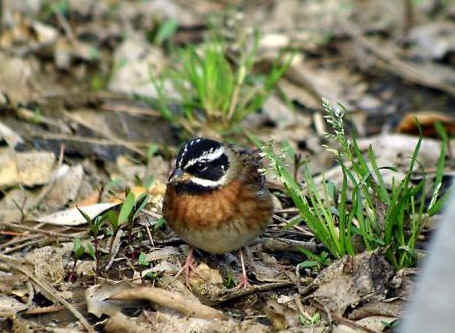
Tristram's
Bunting
- Common Reed Bunting ______ mid-apr,
early-may, mid-may 01, 06, 07, 10
Emberiza schoeniclus
O-jurin





















